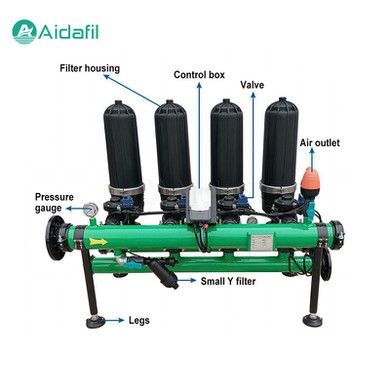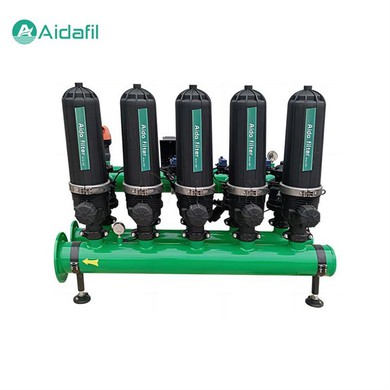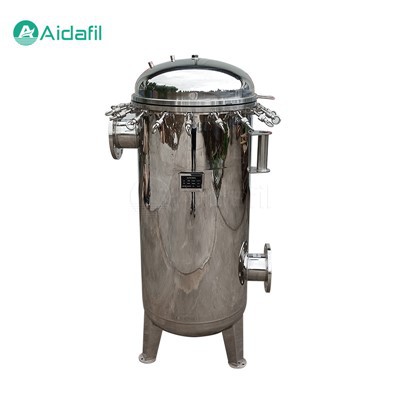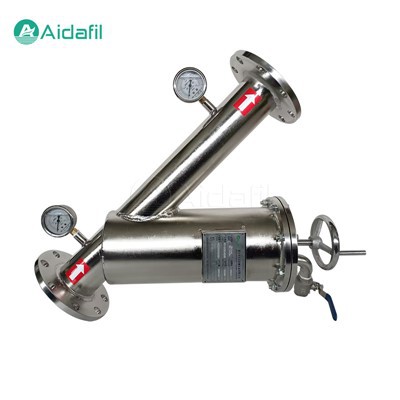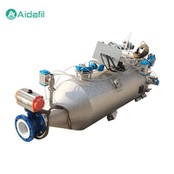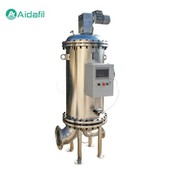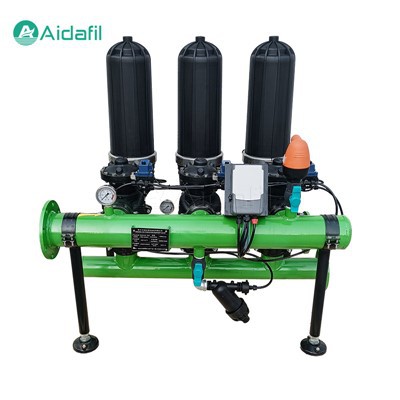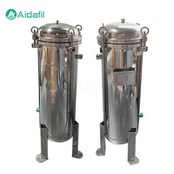
Exquisite-Design Practical Disc Filter
Product Details
As a highly efficient and precise filtration device, the exquisite-design practical disc filter consists of multiple plastic (such as PP) discs that are pressed together by springs and fluid pressure, forming numerous fine channels for filtration. When liquid passes through these discs, solid particles are trapped within the channels, thus achieving the filtration effect.
The exquisite-design practical disc filter achieves effective removal of solid substances from water through multi-point (typically 18 to 32) deep bed filtration. After filtration, the discs can be loosened manually or automatically to perform backwashing and remove the retained impurities.
Suitable for a variety of water qualities and application scenarios, such as the food, textile, metallurgy, plastics, pharmaceutical, building materials, paper industries, as well as HVAC systems, irrigation, wastewater treatment, and other fields.
Parameters
|
Working pressure |
0.2Mpa ~ 0.8Mpa |
|
Backwash pressure |
0.15Mpa ~ 0.8Mpa |
|
Working temperature |
<60°C |
|
pH value |
4 ~ 13 |
|
Filter element number |
2 ~ 10 |
|
Filter accuracy |
20μm ~ 200μm |
|
Inlet pipe |
Plastic material, flange connection |
|
Outlet pipe |
Plastic material, flange connection |
|
Drain pipe |
Flange connection |
|
Backwash valve |
Plastic material |
|
System control |
Fully automatic special control system, with IP65 international standard insulation class |
Working processes
1. Filtration process
- The discs are pressed together tightly by the spring force and the pressing force formed by the pressure difference between the inside and outside of the gland to form a tight filter element to prevent the penetration of impurities in the water.
- The raw water enters the filter and passes through the filter element.
- Suspended impurities are intercepted between the outer discs and the discs.
2. Backwashing process
- The controller sends a signal to turn off the water inlet and open the sewage. At this time:
- The clean water filtered by the filter unit controlled by the controller enters the water outlet of the backwashing filter from the opposite direction.
- The skirt of the rubber cone bucket is opened by the pressure of the water, and the water flow can only enter each backwash pipe.
- Pressurized water is ejected from a nozzle mounted on the backwash pipe.
- The pressure water in the backwash tube also enters the piston cover at the same time, pushes the gland up, and loosens the disc pressed by it.
- The water jet along the tangential direction drives the released disc to rotate rapidly, and at the same time initializes the intercepted impurities.
- The backwash water carries the initialized impurities away from the sewage outlet.
Advantage
The exquisite-design practical disc filter offers the following advantages:
1. High removal rate. Can remove very small particles.
2. Maximum capacity. Can handle large amounts of fluid.
3. Low pressure drop. Due to its large filtration area, the pressure drop is very low.
4. Easy to maintain. Discs can be easily replaced without the need for special tools.
5. Chemical resistance. Made of materials that are resistant to chemical corrosion.
Maintenance
In order to ensure the long-term stable operation of the disc filter, regular maintenance and maintenance are required.
1. Regularly check the inlet and outlet pressure of the filter. When the pressure difference exceeds a certain range, it should be cleaned promptly.
2. The cleaning cycle should be based on the actual water quality, generally once a week to once a month.
3. When cleaning, the inlet and outlet valves of the filter should be closed first, and then the drain valve should be opened for backwashing.
4. If the filter unit needs to be disassembled for cleaning, care should be taken to avoid damage to the filter medium.
5. Regularly check the control system to ensure that valves, instruments, etc. are working properly.
Selection criteria
When selecting a disc filter, consider the following factors:
1. Fluid Type. Ensure that the filter media is compatible with the fluid.
2. Particle size. Select a filter medium with the appropriate pore size.
3. Flow. Select a filter that can handle the required flow.
4. Pressure. Ensure that the filter can withstand the pressure of the fluid.
Chemical compatibility. Ensure that the filter material is compatible with the fluid.
5. Maintenance costs. Consider the cost of disc replacement and maintenance.
FAQ
1. Q: What is the function of a filter?
A: The main function of a filter is to remove solid particles, impurities, and harmful substances from liquids or gases, in order to achieve purification, clarification, and protection of equipment.
2. Q: How to choose a suitable filter?
A: When choosing a filter, factors such as the properties of the material being filtered (e.g., viscosity, temperature, corrosion), required filtration accuracy, processing capacity, operating pressure and medium, as well as the type, material, size, and installation method of the filter should be considered.
3. Q: What is the working principle of a filter?
A: The working principle of a filter mainly relies on physical screening, deep interception, absorption, or chemical reactions to remove impurities or harmful components from the material being filtered.
4. Q: How to maintain and care for a filter?
A: Maintenance of filters includes regular cleaning or replacement of filter elements, inspection of seals and fasteners, maintaining stable operating pressure, and avoiding overloading. Specific methods should be referenced from the filter's instruction manual and maintenance guides.
5. Q: What is the service life of a filter?
A: The service life of a filter depends on its working environment, processing volume, and filtration accuracy. Generally, when the filter's pressure drop reaches a certain value or the filtration effect decreases significantly, it needs to be replaced or cleaned.
6. Q: What should be paid attention to during filter installation?
A: During filter installation, attention should be paid to the directionality, ensuring that the fluid enters and exits from the correct ports. Also, the piping system should be cleaned before installation, and the filter should be securely fastened and sealed as required by the instructions.
7. Q: What is the replacement cycle for filters?
A: The replacement cycle for filters depends on their working conditions and filtration requirements, and is usually indicated by pressure difference indicators or timers. When the filter's pressure drop reaches the set value or the filtration effect decreases, it should be replaced in a timely manner.
Why Choose Us
· Professional manufacturer with many years' experience
· Good quality with competitive price
· OEM & ODM are welcome
· Various payment items are acceptable
· Good service by experienced manager
AIDA Philosophy
1. Management Concept:
· Satisfy the customers' demand --- Touch customers, trust with our products and services
· Make employees happy --- Pursue higher material and spiritual happiness
2. Company Mission:
· Focus on customer needs, provide best filtering solution
· To be the lifelong partner with customers
3. Corporate Vision:
· Become a global purification leadership brand
4. Values:
· Customer: Pursue the ultimate experience, enjoy excellent quality
· Team: Trust, responsibility, growth, win-win
· Work: Simple, sincere, efficient, dedicated
Hot Tags: exquisite-design practical disc filter, China, factory, price, buy, efficient compressor oil separator, efficient self cleaning screen filter, 10 micron hydraulic fluid filter, oil separator screw compressor, 10um compressor oil filter, 480mm separator filter

